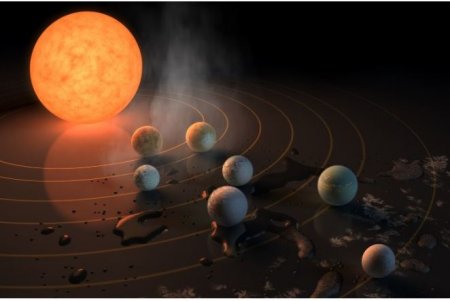P
ProfRem
Guest
Astronomers have found a nearby solar system with seven Earth-sized planets, three of which circle their parent star at the right distance for liquid surface water, bolstering the prospect of discovering extraterrestrial life, research published on Wednesday showed.
The star, known as TRAPPIST-1, is a small, dim celestial body in the constellation Aquarius. It is located about 40 light years away from Earth, close by astronomical standards, but about 44 million years away at the average cruising speed of a commercial passenger jet.
According to Reuters, Researchers said the proximity of the system, combined with the proportionally large size of its planets compared to the small star, make it a good target for follow-up studies. They hope to scan the planets’ atmospheres for possible chemical fingerprints of life.

“The discovery gives us a hint that finding a second Earth is not just a matter of if, but when,” NASA chief scientist Thomas Zurbuchen said at a news conference on Wednesday.
The discovery, published in this week’s issue of the journal Nature, builds on previous research showing three planets circling TRAPPIST-1. They are among more than 3,500 planets discovered beyond the solar system, or exoplanets.
“This is the first time that so many Earth-sized planets are found around the same star,” lead researcher Michael Gillon, with the University of Liege in Belgium, told reporters.
From the vantage point of telescopes on Earth, the planets’ motions regularly block out bits of the star’s light. Scientists determined the system’s architecture by studying these dips.
“The data is really clear and unambiguous,” Triaud wrote in an email to Reuters.
The star, known as TRAPPIST-1, is a small, dim celestial body in the constellation Aquarius. It is located about 40 light years away from Earth, close by astronomical standards, but about 44 million years away at the average cruising speed of a commercial passenger jet.
According to Reuters, Researchers said the proximity of the system, combined with the proportionally large size of its planets compared to the small star, make it a good target for follow-up studies. They hope to scan the planets’ atmospheres for possible chemical fingerprints of life.

“The discovery gives us a hint that finding a second Earth is not just a matter of if, but when,” NASA chief scientist Thomas Zurbuchen said at a news conference on Wednesday.
The discovery, published in this week’s issue of the journal Nature, builds on previous research showing three planets circling TRAPPIST-1. They are among more than 3,500 planets discovered beyond the solar system, or exoplanets.
“This is the first time that so many Earth-sized planets are found around the same star,” lead researcher Michael Gillon, with the University of Liege in Belgium, told reporters.
From the vantage point of telescopes on Earth, the planets’ motions regularly block out bits of the star’s light. Scientists determined the system’s architecture by studying these dips.
“The data is really clear and unambiguous,” Triaud wrote in an email to Reuters.

